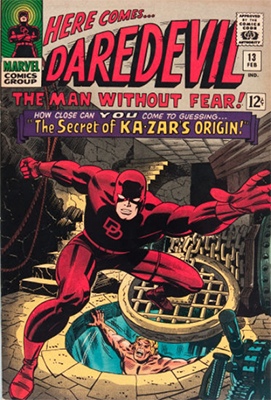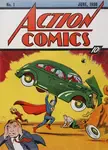Undervalued Comics: Daredevil 13, 1st Vibranium
Why Daredevil 13 is an Undervalued Comic
Every person who’s ever seen a Marvel movie — and at this point, that’s literally all the people —knows what vibranium is. After all, in the Marvel Cinematic Universe, vibranium is no mere McGuffin, mystery box, or magnetic plot device. It’s a driving force that has taken on an almost mythical, Grail-like importance.
That being the case, you’d think the first appearance of the stuff in comics would sell for a lot more than it does. But Daredevil #13 is truly undervalued in that regard.
Currently, even in a slab, it trades at less than $100 in any condition below 5.0, while even a 9.0 can’t manage $200. How can that be?
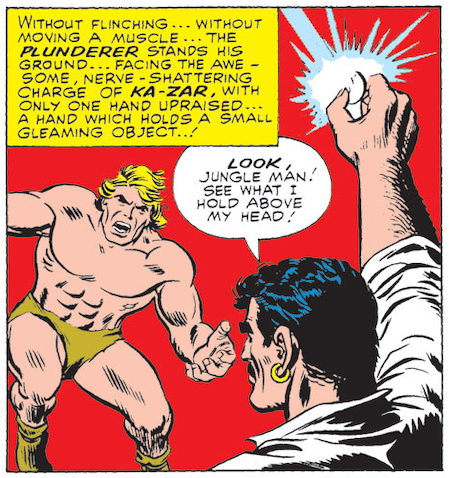 Daredevil 13: first Vibranium panel
Daredevil 13: first Vibranium panelHere’s the thing — when writer/editor Stan Lee and plotter/penciller Jack Kirby created vibranium, they didn’t even know it themselves. In fact, at the time, Lee called this mysterious new space ore “anti-metal.” And getting from anti-metal to vibranium did take a bit of reverse-engineering.
Thus, the frustration for key collectors and others who enjoy tracking even the most obscure movie references back to their comic books origins. Yeah, the whole “anti-metal” thing really throws most forensic fanboys right off the scent.
But we’re here to set you straight.
Daredevil #13, published Dec. 2, 1965, is the middle chapter of a three-issue arc that established the origin of Ka-Zar, following his debut in X-Men #10 earlier that year. (Or maybe we should refer to X-Men #10 as Ka-Zar’s third first appearance... Don’t worry, we’ll get to that.)
Anyway, in Daredevil #13, anti-metal is said to have come from a meteorite that crashed into Antarctica millennia ago. Unearthed in the Savage Land by Lord Robert Plunder, it was found to have several strange properties, including the ability to dissolve any other metal.
Plunder then locked away his newfound space rock. Why? So the plot could happen. But before he did so, Plunder splintered off a small piece and fashioned It into a medallion, which he then broke in half, giving a piece to each of his sons, Edgar and Kevin. When joined, the two halves would form a key to unseal the anti-metal, allowing the boys access to their inheritance.
Personally, we would’ve preferred cash. Or gift cards. But whatever.
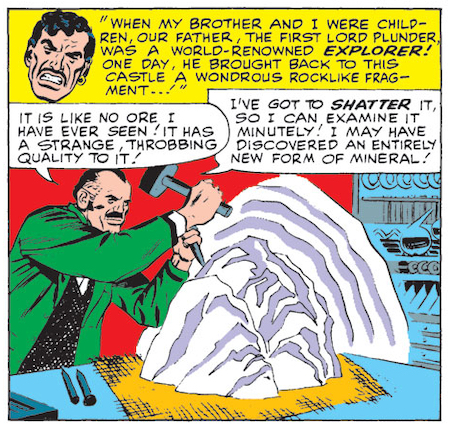 Daredevil 13: Discovery of Vibranium
Daredevil 13: Discovery of VibraniumAs often happens in comics, Plunder’s plan went awry. His sons grew estranged. Edgar grew up to become the villainous pirate known narcissistically as The Plunderer. Kevin, meanwhile, lost as a boy in the Savage Land, become Ka-Zar the Great, learned how to pal around with a saber-toothed tiger, and forgot how to speak proper English.
All this makes Daredevil #13 something of a double key. It’s the first appearance of vibranium, yes, but it’s also the origin of Ka-Zar, and the revelation of his actual name.
Actually, the issue is kind of a triple key, given that the Daredevil figure on this cover, either cropped by itself or with the background intact, may well be the most-used image of the character, seen on a near uncountable number of merchandised items.
But getting to this “first third appearance” thing — Ka-Zar actually predates Marvel Comics. The character made his debut in a titular pulp title, circa October 1936. That Ka-Zar was a pure Tarzan clone named David Rand. But this primordial version only managed two additional prose outings before getting shuffled off to the same elephant graveyard where all the ersatz ape men go to die. Or so it seemed.
Some three years later, when pulp magnate Martin Goodman was casting about for material to stuff into his first comic book, cartoonist Ben Thompson unearthed Goodman’s Ka-Zar pulps, probably at Goodman’s direction, and adapted its story, “King of the Fang Claw,” for Marvel Comics #1.
The Golden Age Ka-Zar would go on to appear in the first 26 issues of Marvel Mystery Comics, with one side hustle in Human Torch #5. Then his jungle vine snapped and Ka-Zar plummeted back into limbo.
But you can’t keep a good savage down. During its Atlas era run the mid-1950s, Marvel dusted of the character for use in all six issues of Jungle Action. Except this time his name was Lo-Zar.
Like Ka, Lo’s chief characteristic that made him distinct from Tarzan was the fact that her had blond hair, not black. Otherwise same-same. Except that Lo-Zar did add a wrinkle to the narrative fabric, introducing dinosaurs into the lore, a concept that would be central to Ka-Zar’s schtick with his Silver Age return.
Just five months after Ka-Zar’s Daredevil trilogy, Kirby and Lee would revisit the meteorite-with-strange-properties motif in Fantastic Four #53. That issue, on-sale May 10, 1966, featured the second appearance of Black Panther, along with the first appearance of his nemesis, Ulysses Klaw. But it also gave the world vibranium-proper, using that name for the first time to identify the space rock residents of Wakanda mined for numerous uses.
Given vibranium’s ability to absorb, store, and release all kinds of kinetic energy, including sound waves, it was perfect for weaving into Black Panther’s costume, becoming the source of his speed, strength, and cat-like stealth.
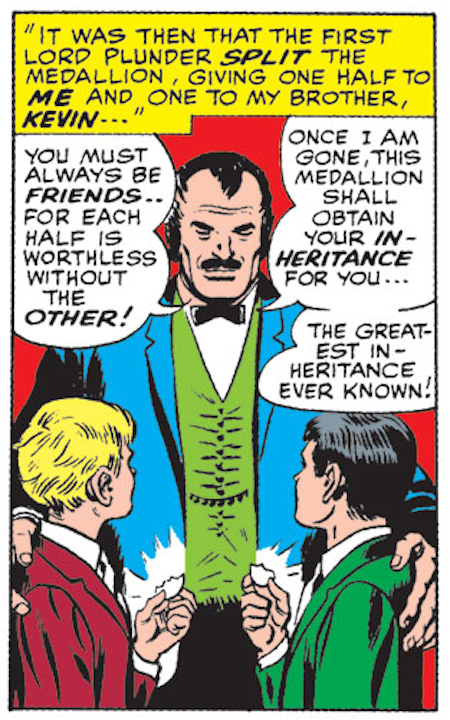 Daredevil 13 KaZar and the Origin of Vibranium
Daredevil 13 KaZar and the Origin of VibraniumNaturally, eagle-eyed fanboys made quick note of the similarity between anti-metal and vibranium. Different properties, but near identical space-based origins presented just a few months apart. And so, soon enough, the mimeograph machines that acted back in the day like analog-Twitter fired up with theories of truly No-Prize proportions.
Fans hate loose ends, and this needed to be tied up. Maybe, they said, anti-metal was another form of vibranium? Maybe it performed its metal-dissolving trick because, being a different isotope, it emitted vibrations rather than absorbing them?
Exactly when and where that theory passed into accepted fact is not clear. But it was definitely canonized by January 1971, when the Ka-Zar story in Savage Tales #1 invoked the vibranium nomenclature.
Since then, vibranium has been further retconned to come in nearly as many varieties as kryptonite, including reverbium, living vibranium, and nuform. Even Captain America’s shield got retconned into being an alloy of vibranium and another Marvelous metal, adamantium.
Today, Lee’s original anti-metal is referred to variously as Antarctic vibranium, Savage Land vibranium, or vibranium-B. And that’s why — although most of them don’t quite realize why, or how they’re technically wrong — all of the fan guides now agree: The anti-metal seen in Daredevil 13 is actually the first appearance of vibranium.
That makes the book a must-have for MCU fans. And that will become especially true if and when Ka-Zar and his Savage Land make their debut in movie theaters, or on television.
Or maybe we should just say "when," because considering the cross-genre coolness of super-heroes vs. dinosaurs, making that flick is kind of a no-brainer.
Guide to Daredevil 13 Comic Book Values
- CGC 9.6 — $3,120 Bowling Green Pedigree
- CGC 9.6 — $750 (Jun. 2019)
- CGC 9.4 — $685
- CGC 9.2 — $325 (Jun. 2020)
- CGC 9.0 — $237
- CGC 8.5 — $157
- CGC 8.0 — $151 (Jul. 2021)
- CGC 7.5 — $160
- CGC 7.0 — $160
- CGC 6.5 — $215
- CGC 6.0 — $143
- CGC 5.5 — $105
- CGC 5.0 — $115
- CGC 4.5 — $81
- CGC 4.0 — $65
- CGC 3.5 — $33
- CGC 3.0 — $66
- CGC 2.5 — $20
Get your copy of Daredevil #13 now. As we noted above, it’s still cheap enough, but there is the recent sale of CGC 6.5 for $215 that presages a round of price hikes coming down the pike. And if you think $200 seems steep for a 6.5 when 8.0s are selling for $150, brother that’ll seem cheap for a 1.5 once Ka-Zar, Zabu, and Savage Land vibranium appear on screen.
Luckily, Daredevil #13 is pretty plentiful, with 437 copies recorded in the CGC census, 28 of them signed.
But as one final recommendation on this book — while we consider it a bargain buy in all CGC grades, the fact that it’s been largely overlooked by investors until now means that most of the 397 copies graced with CGC’s Universal label are mid- to high-grade. Fewer than 60 copies have been certified below 5.5 and none at all in grades 1,0 to 1,8.
So, if you have or can get a a low-grade copy of Daredevil #13, we think it’s worth sending it in now for certification, because if we’re right, and Disney can’t resist bringing the Savage Land to life, demand for this issue will skyrocket, including in the lower grades for as long as they remain within reach for middle-income collectors.
Have this book? Click to appraise its value or Consign Yours for Auction!
INDEX OF UNDERVALUED COMIC BOOKS
Related Pages on Sell My Comic Books
Daredevil Marvel Comics Price Guide

